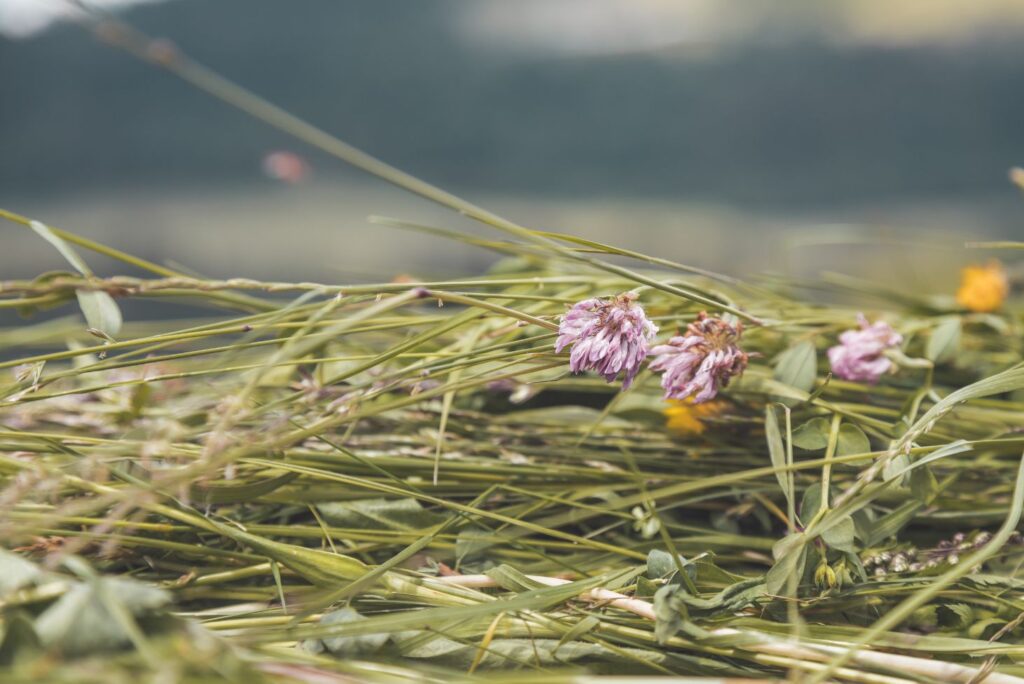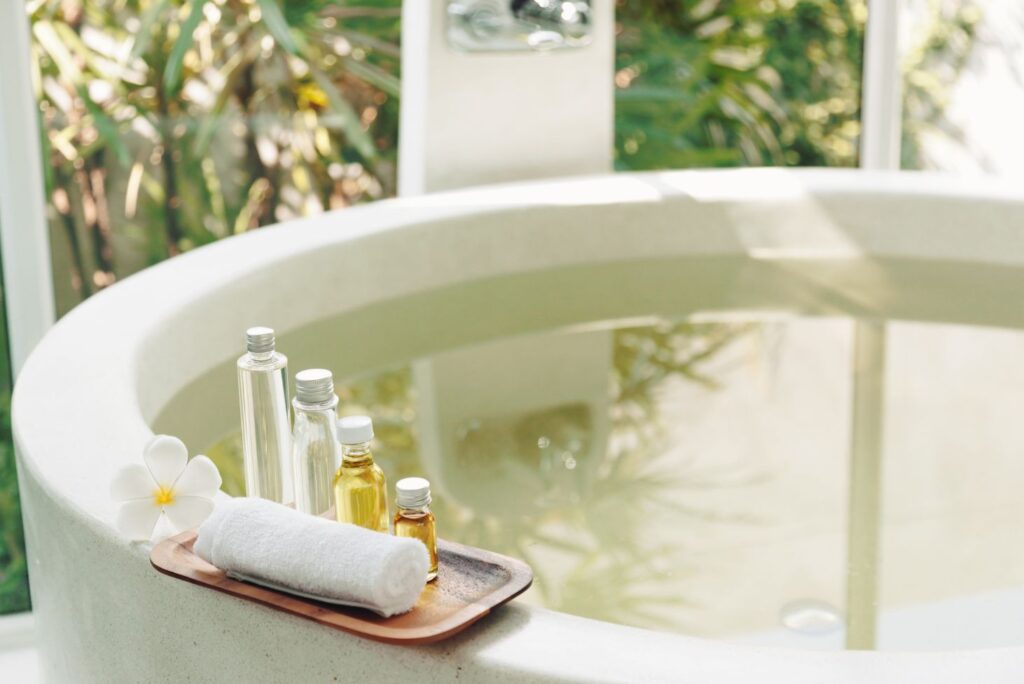Want to know what are the health benefits of hay flower baths, how to harvest hay flowers, and how to use hay flowers in remedies? Continue reading.
Hay flowers (Graminis flos) have been used in folk medicine since ancient times, in all areas of Europe, especially for bathing. Many of the traditions related to the use of hay flowers have been lost yet in some parts of rural Europe healers still use hay flower baths to alleviate heart, circulatory but also nervous system problems. But before we show you the amazing health benefits of hay flower baths, here are a few things that are good to know.

In This Article You Will Find:
What Are Hay Flowers?
A handful of hay flowers usually contains no less than ten species of different medicinal plants, which make up a formidable health recipe with countless therapeutic properties. In order to give you a more accurate idea of the health benefits of hay flowers and hay flower baths, we will nominate only ten medicinal plants, out of the total of 60 that we frequently encounter in haystacks.
- Plantago (Plantago major & Plantago lanceolata) is one of the most used medicinal plants topically in Romanian folk medicine. It is anti-inflammatory, soothing, antiseptic, cicatrizing, and helps restore tissues thus it is used to calm stings, and itching, to speed up wound healing, and to fight skin infections.
- Meadow Buttercup (Ranunculus acris) it is an irritant-convulsive, antispasmodic, anti-neuralgic, and antibiotic medicinal plant. It is popularly used to treat rheumatism, neuralgia, dermatosis, and back pain (sciatica).
- Lady’s Bedstraw (Galium verum) is cicatrizing, speeds up tissue recovery, clears the skin, and helps restore normal skin pigmentation.
- Red Clover (Trifolium pratense) is an antiseptic, antirheumatic, antiasthmatic, anti-inflammatory, and decongestant medicinal plant with mild sedative action.
- Hogweed (Heracleum sphondylium) is frequently encountered in hay harvested from the mountain areas in the months of July-August-September. It has nerve tonic and antitumor properties and is a traditional remedy for multiple sclerosis.
- St. John’s Wort (Hypericum perforatum) is par excellence a soothing plant for the skin, being used for skin allergies, itching and stinging, and liver diseases. Used in hay flower baths, it has calming and even hypnotic properties (induces sleep).
- Wild Strawberry leaves & flowers (Fragaria vesca) have cicatrizing properties and are used to treat gingivitis and speed up wound healing.
- Angelica (Angelica archangelica) is found in hay harvested in the fall from mountain areas, from wetter lands with sandy soil. Used externally, it has skin regenerative, anti-inflammatory, and cicatrizing properties. It seems that when used externally with consistency, it accelerates the healing of internal conditions (infections, assimilation disorders, nervous disorders).
- Dyer’s Greenweed (Genista tinctoria) is traditionally used internally to treat hypothyroidism, kidney diseases, and body detoxification (seeds). Its healing properties are still little known from a scientific point of view.
- Wild Mint (Mentha arvensis) is anti-inflammatory, comforting, stimulates breathing, being a good antiseptic for the upper respiratory tract.

The Four Types of Hay Flowers
- The first hay cut of the year is used mainly for increasing resistance to diseases, detox, rejuvenation, and natural skin care.
- The hay flowers from the second cut are used for colds, lung and throat diseases, and to treat infections, rheumatism, and kidney problems.
- The hay flowers from the shadier and wetter coasts are used to treat diseases caused by cold and dampness.
- The hay from the sunny and dry coasts is more aromatic and is used for refreshment, invigoration, and increasing resistance to diseases.
How to Harvest Hay Flowers
Hay flowers (Graminis flos) are obtained by shaking the hay immediately after it has dried. Thus, the flowers, seeds, and leaves of the medicinal plants that grow together with the grass are sifted through the “sieve” made of dry straw. To obtain these flowers, the hay must be shaken while it is fresh (immediately after drying), otherwise, they shake off and may be lost or degraded during storage.
The hay flowers obtained from the hay of the respective year have the greatest therapeutic value, and over time they lose their healing power. If you didn’t manage to harvest the hay flowers in time, you can use the hay as such, but you need to increase the concentration of the extracts used.

How to Make Hay Flower Baths – Health Benefits of Hay Flower Baths – Phytobalneotherapy
1. Hot Hay Flower Bath
How to Make
Add 10-15 handfuls of hay flowers to five liters of boiled water. Steep for 15-20 minutes, stirring from time to time. Strain the infusion and pour it into your hot bath water, adjusting the water temperature so that it reaches 38-40°C/100-104°F. Bathe for 20-30 minutes, during which time you must maintain the water warm by either adding more hot water or more hot hay flower infusion.
Health Benefits of Hay Flower Baths -Hot Bath
One of the key health benefits of hay flower baths is that they help activate the blood flow, thus allowing the active principles from the medicinal plants to be absorbed quickly into the skin. It increases on the spot the body’s natural defense mechanisms against infections, and it is also an excellent remedy for kidney infections and cystitis, rheumatism, gout and the early stages of flu. The hot hay flower bath is recommended for people with high sensitivity to cold and cold air currents. You can also use the hay flowers infusion for feet or sitz baths using a basin. In this case, use only the cooled hay flower infusion (37-39°C/98-102°F) without adding water.
Safety & Contraindications
When fully bathing, increase the bathwater temperature gradually, starting from 36-37°C/96-98°F to 38-40°C/100-104°F. The hot hay flower baths are not recommended for people suffering from high blood pressure, cardiac ischemia, epilepsy, thrombophlebitis, severe forms of arteritis obliterans, and those who have suffered cardiovascular accidents.

2. Cold Extract Hay Flower Bath
How to Make
Soak 15-20 handfuls of hay flowers in 10 liters of room temperature water for 10-12 hours, or overnight. Strain the cold maceration and add it to your bath water, which must have a temperature below 40°C/104°F.
Health Benefits of Hay Flower Baths – Cold Maceration
This is one of the most natural ways of extracting the active principles from hay flowers, in addition to preserving certain of their bioenergetic properties. The cold extract hay flower baths have the most pleasant aroma (very close to that of hay), being for this reason very popular. This cold extract hay flower bath is recommended with a predilection for psycho-somatic conditions (physical disorders triggered by the nervous system) and nervous system conditions.
The main disadvantage of this form of preparation is that certain active principles from hay flowers (such as tannins – very useful in the treatment of skin diseases) are not extracted through the cold maceration process. For this reason, the full hay flower extract that we present to you below is the best for skin problems.
3. Full Plant Extract Hay Flower Bath
How to Make
Soak 7-10 handfuls of hay flowers in 5 liters of water at room temperature for 8-10 hours, or overnight. Strain the cold maceration and put it aside in a bowl. Add 3-4 hands of fresh flowers to the already used hay flowers, are boil them for 1-2 minutes in another 5 liters of water. Leave aside to steep for another 20-30 minutes. After the decoction has cooled, strain and combine it with the cold maceration obtained earlier. Pour this full plant extract into your bathwater for a relaxing bath.
Health Benefits of Hay Flower Baths – Cold Maceration
This hay flower extract contains both the active principles obtained through cold maceration and those extracted at high temperatures, being for this reason the most active. Its only disadvantage: it is more difficult to develop. This hay flower bath helps boost natural immunity, kidney infections, and skin conditions, as well as for migraines or insomnia.

How to Make Hay Flowers Cataplasm
In addition to the amazing hay flower baths, you can also use hay flowers to make cataplasms or poultices. There are two types of cataplasms that you can make with hay flowers, and they both work for cystitis and kidney diseases, skin diseases, rheumatism, insomnia, and migraine.
- Hot Cataplasm with Hay Flowers – scald a handful of hay flowers in a cup of boiling water for 10-15 minutes. Remove the hay flowers, and strain them well. Wrap the hay flowers in a piece of gauze and apply them to the affected area, as warm as possible.
- Cold Cataplasm with Hay Flowers – grind a handful of hay flowers using a coffee grinder or crush them in a mortar. Add a tiny bit of warm water (37-42°C) over them and let them sit for 1-2 hours. Wrapped the wet hay flowers in gauze and apply to the affected area.

The Miraculous Health Benefits of Hay Flower Baths
Hay flowers were one of the main therapeutic “weapons” of the famous herbalist and priest Sebastian Kneipp – the father of natural medicine in Europe. He mentioned of them: “Hay flowers have never betrayed my trust, from the treatment of blood poisoning, frostbitten limbs, to the treatment of rheumatism, scrofulous diathesis or spastic affections of the lower abdomen”. Many other naturopathic therapists, such as Kuhn, Suvorin, Maria Treben, etc. used the miraculous hay flowers to treat the most diverse ailments. Indeed, there are many health benefits of hay flower baths, a lot of which we still don’t know.
Read Also: Health Uses of Summer Flowers – 9 Amazing Summer Flowers
If you’ve enjoyed learning about the health benefits of hay flowers, how to harvest hay flowers, and how to use them in healing hay flower baths, please share this article. This way we can reach more people who want to know this information. Let us know in the comments below if you’ve ever bathed in hay flowers or if you’ve ever heard of them. Stay healthy, naturally!
Share on Pinterest ❤️

